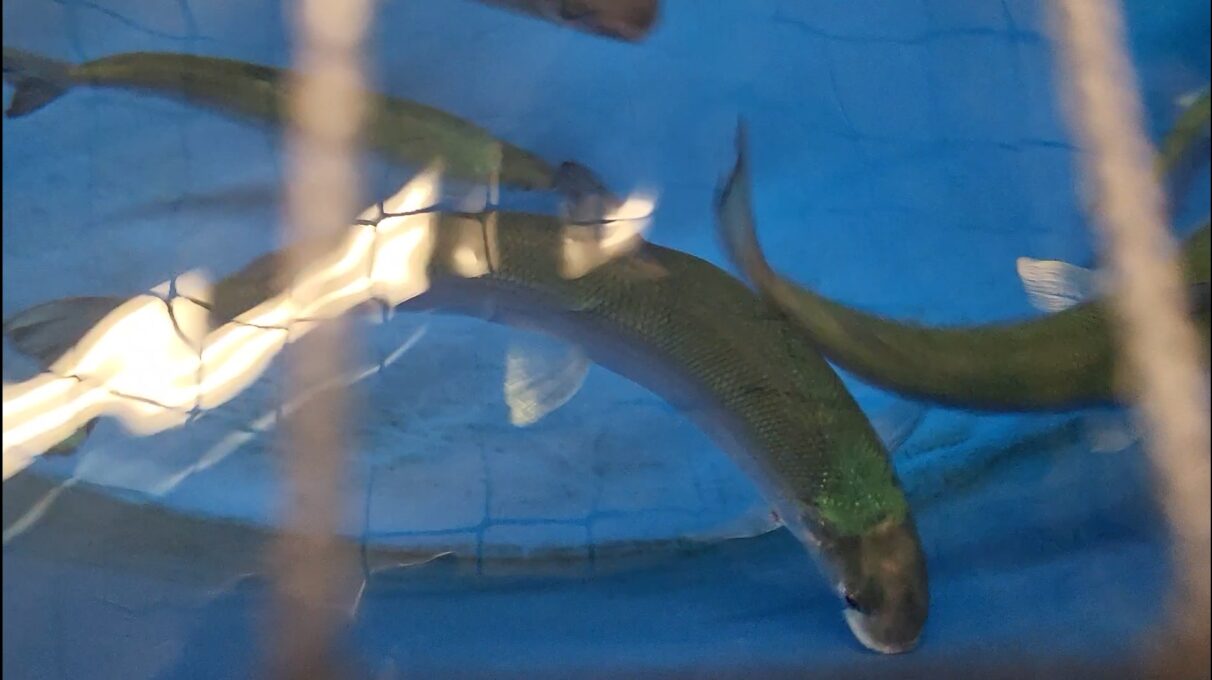‘We still have a chance’: Fighting for the Atlantic whitefish
Students, researchers use art to raise money for critically endangered species

caption
Aidan Skinner (left) and Tara Everding at their information booth on Atlantic whitefish in the Halifax Central Library.
Tara Everding and Aidan Skinner sat at a booth nestled in the Halifax Central Library throughout February, talking to people about fish. Related stories
But not just any fish. The two Dalhousie students have been schooling library patrons about the Atlantic whitefish, one of Nova Scotia’s oldest and most endangered species.
As a species, Atlantic whitefish have been around for at least 10,000 years. They are anadromous, a species born in freshwater that migrates to the ocean and returns to spawn in their birthplace river or lake.
The fish bring nutrients from the ocean back to nutrient-poor fresh waters, playing an essential role in Nova Scotia’s aquatic ecosystem. The Atlantic whitefish only exists in one place on Earth — Petite Rivière, N.S.
Everding, Skinner, and two other Dalhousie students partnered with a program run by activist group Youth Challenge International to raise awareness and funds for Atlantic whitefish research. Their poster and T-shirt sales money goes directly to Coastal Action, a non-profit conservation group based in Mahone Bay. Their mural, created by student artist Lucian Mae, grabs the eyes of passersby.
“People have been pretty attracted to it,” Everding told The Signal during a recent interview.
“We wanted to find a good middle ground to communicate the science in a way that the general public could easily digest it,” added Skinner. “Something that’s eye-catching but also something that has substance to it.”
Everding and Kinner posted a simplified copy of Canada’s Atlantic Whitefish Action Plan to their bio page on the social media aggregator Linktree.
Dalhousie researcher Paul Bentzen and his team are continuing efforts to regrow the Atlantic whitefish population and improve scientists’ understanding of its genetics to increase support for the population in its natural habitat.
“It is our oldest and most endangered species,” Bentzen said. “This is what we have here in Nova Scotia, and this is what we are very close to losing.”
Bentzen said the fish is an “unusually” ancient species, estimated to have separated from all its living relatives 13 to 14 million years ago.
“That is like comparing orangutans and humans,” says Bentzen.
Bentzen said losing the Atlantic whitefish would mean losing an entire lineage with no close relatives.
John Batt works with Bentzen at Dalhousie, managing the Aquatron tanks that house the fish.
Most fish will be tagged for tracking, while Dalhousie will use the remainder to maintain breeding. New eggs spawned in February. Some of the fish from these eggs will be released later this year.
Batt said the tanks require constant attention. Tank temperatures are kept close to their natural environment, with jet pumps simulating currents. A manufactured trout diet replicates the tastes of what researchers believe is their natural diet.
“There’s not enough of them to study what they eat in the wild,” said Batt, looking down at the shimmering flashes of green and silver in the tank. “This is potentially the end of a species right here.”

caption
An adult Atlantic whitefish swims in the Dalhousie Aquatron. This fish will be released into Petite Riviere sometime this year.One Aquatron tank holds about 300 fish. Batt estimates that several of Dalhousie’s Aquatron tanks house about 1,200 adult Atlantic whitefish in total.
“There’s more in this room than in the wild,” said Batt. Researchers are unsure of the exact number but believe it to be in the low hundreds.
Bentzen said the species will not survive in tanks on a university campus.
“It belongs in the wild, and we have to find a way to make it secure there,” said Bentzen. “We still have a chance, just a little chance, of restoring it and creating healthier ecosystems.”
Coastal Action project co-ordinator Amy Russell shares Batt’s and Bentzen’s sense of urgency. Since 2018, Russell and her team have been the eyes on the ground for Dalhousie researchers, removing invasive species such as chain pickerel and collecting fish for breeding.
Unlike the Atlantic whitefish, chain pickerel are a secure and widely distributed species that cause ecological harm in Nova Scotia by depleting native fish populations.
Their new Atlantic Whitefish Streamside Rearing Facility in Petite Rivière will begin operating in the spring. The facility will cycle in water to and from the river, easing the fish’s transition from captivity to their natural ecosystem.
Russell expressed pride at Coastal Actions’ restoration progress. “I’ve seen whitefish in the water on several occasions,” said Russell.
“I think that’s very exciting. It’s a constant battle, but I think staying on top of that is really important.”
Russell said raising public awareness is “inherently valuable” to conservation efforts.
“Combining art and science is awesome, and it absolutely helps raise awareness,” said Russell.
Everding and Skinner plan to expand their information outreach through signs on Lunenburg trailheads.
“I know they don’t look like much. I know they just look like a fish,” said Skinner. “A big part of this project is making these ordinary organisms look more exciting. There’s more to them than meets the eye.”
About the author
Serra Hamilton
...
